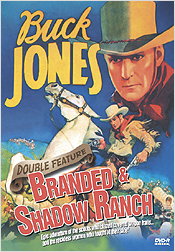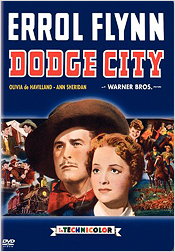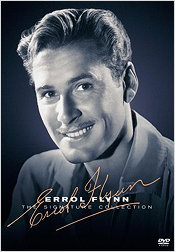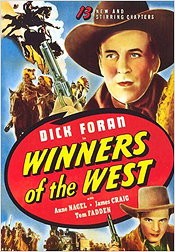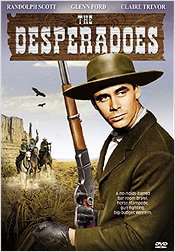 |
Site created 12/15/97.

page created: 4/28/05
 Barrie Maxwell - Main Page |
||||||||||||||||||||||||||||||||||||||||||||||||||||||||||||||||||||||||||||||||||||||||||||||||||||||||||||||||||||||||
| Western
Roundup #1 - April 2005 Welcome to this first edition of the Classic Coming Attractions column devoted exclusively to westerns. With all the westerns scheduled to appear over the next three months, this seemed like the appropriate time to debut this sort of an offering. In the future, the column will appear on an irregular basis, somewhat driven by the level of release activity of westerns on DVD. Coverage will extend to all westerns, not just those from before the mid-1960s, which so far has been my admittedly very loose cut-off date for classic content. That's not unreasonable for westerns, I feel, given the decline in the number of westerns produced after the 1960s. I can be all-inclusive, but at the same time know I'll be concentrating my efforts on the classic era just by virtue of the genre's history of production. In this outing, I'll be looking at the westerns of James Stewart and Henry Fonda, there'll be reviews of a number of current western DVD releases; and finally, I'll have a summary of upcoming westerns announced for DVD release. So let's head 'em out! The Westerns of James Stewart and Henry Fonda It probably would be more appropriate to write about John Wayne or one of the most well-known B-western stars in an inaugural western column like this, but Wayne gets plenty of attention as it is and few of the B stars are well represented on DVD in really decent transfers. Hopalong Cassidy and Gene Autry are exceptions and I will deal with them in the future, but for now, I thought I'd concentrate on two top stars of the classic film era who certainly didn't start out in westerns or even at first seem particularly likely to fit the western mold - James Stewart and Henry Fonda. Later, however, they would both become particularly reliable western performers. Each was cast in 19 westerns including three in which they both appeared. It's also appropriate to bracket the two together because they were close friends off the set and occasionally vied for the same roles. Even a recent article in "Premiere" magazine which provides a listing of the top 50 movie stars (no matter how misguided much of its results are) does find Stewart and Fonda listed at numbers 9 and 10 respectively, which actually isn't far off the mark. James Stewart spent the early part of his career under contract to MGM. During that time, it is stretching it to say that he appeared in two westerns. The first was 1936's Rose Marie - the Nelson Eddy/Jeanette MacDonald version wherein Stewart plays MacDonald's younger brother who is being hunted for murder by the Mounties. It was his second film and one that some would hesitate to classify as a western. 1939's Destry Rides Again was more like it, although Stewart's role as the son of a famous sheriff was a folksy one that had him eschewing gunplay until the film's climax. Stewart was loaned out to Universal for the role, co-starring with Marlene Dietrich in a wonderful blend of light comedy and traditional western action. Stewart's early difficulty in finding effective roles after the end of World War II convinced him that a change in his film persona was needed. He began to search out parts that allowed him to portray tougher characters and one result of this was a greater preponderance of westerns in his filmography. The first western released was Winchester '73, a Universal production that marked the beginning of a seven-year relationship with director Anthony Mann. The deal with Universal that brought about the making of this film allowed for profit participation by Stewart, but also included a non-exclusivity clause, which explains why the Stewart-Mann western collaborations were also made at Columbia and MGM as well as Universal. Winchester '73, in which Stewart tracked down his stolen rifle and the man who took it, introduced the sort of gritty characterization that Stewart was looking for, but even better, was a marked commercial success indicating that the public was accepting of Stewart in a traditional western role. While James Stewart would take the better part of two decades to come into his own in westerns, Henry Fonda didn't appear likely to be much different at first. Like Stewart, he made his film debut in 1935 and cultivated a somewhat placid persona in many of his early films. Yet with Fonda, there was always a hint of something darker lurking beneath and so when he got a chance at a western in 1939 playing Frank James, brother to Tyrone Power's title character in Jesse James, the acceptance of him as a western character was almost immediate. A starring role in the stirring Drums Along the Mohawk soon thereafter confirmed Fonda's suitability for outdoor frontier dramas. These successes led Fonda to return to the western on a regular basis throughout his career. Under contract to Fox during much of the 1940s, Fonda starred in some of that decade's best westerns. First was the superior The Return of Frank James, a thoughtful sequel that equaled the quality of its predecessor and was directed with panache by Fritz Lang. Even better were two films that bracketed Fonda's war service, The Ox-Bow Incident in 1943 and My Darling Clementine in 1946. The former was thematically an amazing film to come from a Hollywood studio at that time, while the latter was an excellent telling of the Wyatt Earp saga and continued a fine association between the actor and director John Ford. That association continued after Fonda and Ford both left Fox and resulted in the fine cavalry drama Fort Apache made at RKO for Ford's production company in 1948. This was Fonda's last major film appearance before departing Hollywood for an extended stay on Broadway that included a long run in the play "Mister Roberts". In the meantime, the positive outcome from James Stewart's participation in Winchester '73 was what 20th Century-Fox was waiting for, as it had another Stewart western, Broken Arrow (actually shot before Winchester '73), in the can. The film is often looked upon as an early Hollywood attempt to correct the imbalance of poor portrayals of Indians in its films, even if the studio hedged its bets by casting the non-Indian Jeff Chandler as Cochise. The film was another box office success and along with Winchester '73 signaled the beginning of a decade in which the A or minor-A western would experience its most sustained period of success. James Stewart's appearance in both films was a major reason for their popularity and the success of the 1950s westerns in general can be traced to him in no small measure. Many other major stars of the classic era seldom connected to the western genre in the 1930s and 1940s would follow Stewart's initiative in the decade, including the likes of Tracy, Cagney, Gable, and Taylor. Four more Stewart-Mann films now followed, two from Universal (Bend of the River, The Far Country) and one each from MGM (The Naked Spur) and Columbia (The Man from Laramie). All were exciting, well-acted, and tightly-directed films; which of them is best is very much a personal preference sort of thing. Mine, by a slight margin over The Man from Laramie, is The Naked Spur (naturally the one not yet available on DVD) partly because it also features Robert Ryan prominently. 1957's Night Passage was to be another Stewart-Mann collaboration, but Mann balked at participating due to script issues, so that direction in the end was handed to James Neilson. (This led to a rift between Stewart and Mann that never was fully resolved.) The film itself did turn out to be another good one, with a nice role for Audie Murphy in it too. Stewart then missed out on a role that looked very suited to him in Anthony Mann's next film, Man of the West. Perhaps soured of westerns a little because of these recent disappointments involving Mann, Stewart made no more westerns during the remainder of the decade. But as Stewart was taking time off from the saddle, Henry Fonda was mounting up again after his Broadway stint and the filmed version of his "Mister Roberts" hit play. Both set in western towns, The Tin Star from director Anthony Mann and Warlock from director Edward Dmytryk were excellent entertainments released in 1957 and 1959 respectively, with the latter particularly suggesting an almost cruel toughness in Fonda's gunfighter that would be brought into full bloom a decade later by Sergio Leone. Entering the 1960s and the last two decades of his film career, Fonda would appear in 11 more westerns - almost a third of all the pictures he would do over that period. First up was How the West Was Won in which he had a small role as a grizzled buffalo hunter. Then in the middle of the decade came a rush of four westerns that tend to have been forgotten - A Big Hand for the Little Lady (with Joanne Woodward); Welcome to Hard Times; Stranger on the Run, a good TV movie that also got a limited theatrical release; and the superior Firecreek. Then in 1969 came the real shocker, a role as a cold-hearted, vicious killer in Leone's Once Upon a Time in the West. This was quickly followed by more conventional efforts in Joseph Mankiewicz's superior There Was a Crooked Man… (with Kirk Douglas), the underwhelming The Cheyenne Social Club (directed by Gene Kelly), and a remake of The Red Pony (this time, made for TV). Fonda's farewell to westerns came in 1973's My Name Is Nobody (released in 1974 in North America), appropriately playing an aging gunfighter who wants to retire. Busy like Henry Fonda over the last two decades of his film career, the 1960s and 1970s, James Stewart would add another two-dozen films to his resume. Almost half of them would be westerns. First up were two John Ford efforts, the somewhat overlooked Two Rode Together (with Richard Widmark) and the superior The Man Who Shot Liberty Valance (Stewart's first appearance with John Wayne - he would later have a small role in Wayne's final film, The Shootist). Stewart then undertook a major if unconvincing role as a fur trapper in the Cinerama extravaganza of How the West Was Won before relaxing with an amusing though curious cameo as Wyatt Earp in Ford's Cheyenne Autumn. In 1965, Stewart embarked on a run of five westerns over the next six years, a number of them with director Andrew McLaglen. Shenandoah (1965) and Firecreek (1968, his first real pairing with Henry Fonda - the two had both appeared in How the West Was Won, but not together) were the best of the five outings. The film-going public by now was becoming less interested in Stewart's films, however, and they did progressively less well during the period, although one might also attribute that to the lessening interest in westerns in general as well as the lower quality of the other Stewart films. The Rare Breed (1966) and Bandolero! (1968) were lesser efforts, while 1970's The Cheyenne Social Club (the second real Stewart-Fonda teaming) was completely uninspiring (although Stewart's work was compromised by having to deal on set with the death of his stepson in Vietnam). James Stewart's final appearance in a western was in John Wayne's final film, 1976's The Shootist. The role was a cameo that he agreed to only at the request of Wayne. He plays a doctor who informs Wayne's character that he (Wayne) is dying of cancer, a scene that holds added poignancy now in view of Wayne's actual death from that disease a few years later. Both Stewart and Fonda left fine legacies of great westerns behind them and we are fortunate to have their efforts well represented on DVD so far. Of the 35 titles they appeared in between them, 16 are currently available with another three titles scheduled to be released over the next two months. Another four seem to be likely releases over the next year or so. See the tables below for the details and some recommendations. Among those titles about which nothing much seems to have surfaced to date, those that would be most desirable to have on DVD include The Return of Frank James, Broken Arrow, Two Rode Together, and Firecreek although obviously any of the others would also be most welcome. Of the existing discs, How the West Was Won is much in need of a new transfer. |
||||||||||||||||||||||||||||||||||||||||||||||||||||||||||||||||||||||||||||||||||||||||||||||||||||||||||||||||||||||||
James
Stewart Westerns
Henry Fonda Westerns
|
||||||||||||||||||||||||||||||||||||||||||||||||||||||||||||||||||||||||||||||||||||||||||||||||||||||||||||||||||||||||
| Reviews The following collection of reviews contains a little something for everyone - a western serial, B westerns, A westerns, and a western TV series - and release-wise, covers the period from 1930 to 2004. A total of 22 titles contained in 19 different releases are covered including Columbia's The Desperadoes, Bonanza Town, The Violent Men, and Good Day for a Hanging; Fox's Thunderhead, Son of Flicka and Bad Girls; HBO's Deadwood; Image's The Old West, Blue Canadian Rockies, and Wagon Team; Paramount's Three Violent People; VCI's Buck Jones Western Double Feature, Winners of the West, Red Ryder Double Feature, Volume 7, Red Ryder Double Feature, Volume 8, The Sundowners, and High Lonesome; and Warner Bros.' Dodge City and They Died with Their Boots On. Buck Jones Western Double Feature: Branded (1931) Shadow Ranch (1930) (released on DVD-R by VCI in 2004) In 1930, Columbia had contracted with independent producer Sol Lesser to provide a series of eight westerns. Hearing about this deal, Buck Jones, who was in need of work following a recent financial setback, signed with Lesser to headline the new series. After the success of these films, Columbia moved to sign up Buck directly and they then produced his films themselves with somewhat improved budgets beginning in 1931. Buck remained with Columbia until 1934 when he moved over to Universal. VCI has released a double bill of two of the Buck Jones westerns from the 1930-1931 period of his stay at Columbia - Shadow Ranch and Branded. |
||||||||||||||||||||||||||||||||||||||||||||||||||||||||||||||||||||||||||||||||||||||||||||||||||||||||||||||||||||||||
| Unfortunately,
VCI's DVD offering (actually DVD-R) is workable at best. The source
material is obviously in rough shape and the result is transfers
that are riddled with speckles, scratches and missing frames along
with images that are rather soft with poor contrast and frequently
lacking in detail. As I say, they're watchable, but they're far from
showing off the films to best advantage. The mono sound is quite
rough too with substantial hiss and crackle. There are no subtitles
or supplements. The films are worth seeing particularly if you want
to get an idea of what early sound Buck Jones films looked like, but
the best I can honestly recommend is a rental. Unfortunately that
may be difficult as the disc is hard to find even for purchase other
than directly through the VCI website. Dodge City (1939) (released on DVD by Warner Bros. on April 19th, 2005) Over the years, I have seen many versions of this film from ones chopped to ribbons in order to squeeze it into a 90-minute slot with commercials (and seen on a B&W TV) to the first time I saw it in colour on VHS and the even better presentation on laserdisc. Although still not looking perfect, it's a pleasure now to welcome one of the most entertaining westerns ever made to DVD. Dodge City uses the Wyatt-Earp-cleaning-up Dodge-City story as its inspiration and throws just about everything you could ask for into the mix. Errol Flynn stars as Wade Hatton, a Texas cattleman who drives a herd of cattle to market in Dodge City where he runs afoul of Jeff Serrett who runs things in the lawless town. Of course Wade ends up having to clean things up. Along the way, we get a wagon train trek, a cattle stampede, a race between a stagecoach and a train, a wild saloon brawl, various killings, a romance, assorted shootouts, some comedy, beautiful dancehall girls, and so on. |
||||||||||||||||||||||||||||||||||||||||||||||||||||||||||||||||||||||||||||||||||||||||||||||||||||||||||||||||||||||||
| The
disc is available separately or as part of the new Errol
Flynn Signature Edition from Warner Bros. While Warners
has unfortunately not sprung for an Ultra Resolution restoration of
the three-strip Technicolor film, its presentation is very pleasing
nonetheless. The correctly-framed full-frame transfer looks for the
most part very sharp with bright colour. There are a few instances
where registration problems presumably due to non-uniform shrinkage
of the original negatives cause blurry images, but for the vast
majority of the film, fans of classic Technicolor will not be
disappointed. The mono sound is in good shape, free of hiss or
distortion, and the characteristic authoritative crack of Warners
gunfire is nicely in evidence. A French mono track and English,
French, and Spanish sub-titles are provided. Supplements include a
Warner Night at the Movies 1939 program, the film's theatrical
trailer, and an eight-minute featurette on the making of the film (Dodge
City: Go West, Errol Flynn). The latter is pretty
standard fare although it does include some good footage of the
film's premiere in the real Dodge City - a film junket that
reportedly came close in scope to that in Atlanta for Gone
with the Wind. The Warner Night at the Movies 1939
program is hosted by Leonard Maltin and includes a trailer for The
Oklahoma Kid, a newsreel, the Academy-Award-Winning Drama
Short Sons of Liberty (Claude
Rains), and a cartoon Dangerous Dan McFoo.
Very highly recommended. Winners of the West (1940) (released on DVD by VCI on March 29th, 2005) This 13-chapter 1940 Universal serial is typical of many of the more average western serials - not particularly original and rather repetitive with a B-western plot worthy of about an hour's running time spread out over 247 minutes. Jeff Ramsay is the chief engineer for John Hartford, the president of a railroad company attempting to complete a line through Hellgate Pass and the land beyond as part of a transcontinental service. King Carter, headquartered in the town of Blackhawk, is the self-styled ruler of the land in question and with the help of an Indian band and members of his own gang dressed up as Indians, intends to prevent the construction from going ahead. A succession of skirmishes between the two sides follow, including the kidnapping of Hartford's daughter, Claire. Eventually, Ramsay and his friends manage to pin Carter and his gang in Blackhawk in what they hope will be a resolution to the conflict. |
||||||||||||||||||||||||||||||||||||||||||||||||||||||||||||||||||||||||||||||||||||||||||||||||||||||||||||||||||||||||
| VCI's
two-disc presentation is fair. The serial is correctly presented
full frame, but the image is passable at best. Black levels are
decent, but overall the image is rather dark and shadow detail is
poor. Contrast is acceptable, but there is some blooming of whites.
Speckles and scratches are frequent. The mono sound is clear enough,
although there is some hiss and crackle at times. Supplements
consist of trailers for four serials (Winners
of the West, Adventures of Red
Ryder, Riders of Death Valley,
The Royal Mounted Ride Again)
and biographies for Dick Foran, Anne Nagel, Ford Beebe, and Ray
Taylor. A better choice of western serial from 1940 would be
Republic's Adventures of Red Ryder,
also available from VCI. They Died with Their Boots On (1942) (released on DVD by Warner Bros. on April 19th, 2005) In what would be their eighth and final teaming, Errol Flynn and Olivia de Havilland star in a sweeping epic chronicling the career of General George Armstrong Custer. Of course, there's little truth in it other than the facts that Custer was flamboyant, did attend West Point, did serve in the Civil War, and did die at the Little Big Horn, but who really cares when the story is told with such wit, verve, and skill. For 1942, this film is long at 139 minutes, but it's well acted by the stars, filled with fine supporting vignettes, and loaded with plenty of action by director Raoul Walsh and second unit director B. Reeves Eason who handled much of the climactic Little Big Horn battle (a magnificent sequence with masses of charging horses and a realistic-looking encounter as the cavalry are gradually overwhelmed by the much superior Indian force). Much of the filming was done on location in California at Busch Gardens in Pasadena, the Warner ranch in Calabasas, the Iverson Ranch in Chatsworth, and at Lasky Mesa. |
||||||||||||||||||||||||||||||||||||||||||||||||||||||||||||||||||||||||||||||||||||||||||||||||||||||||||||||||||||||||
| The
disc sports an excellent transfer, one of the two best among the
five films in the Errol Flynn Signature
Edition (the other is The Sea
Hawk). The title is available in the set or individually.
The full frame black and white transfer is bright with excellent
image detail. Some modest grain adds a nice film-like lustre to the
disc. There are a few speckles, but otherwise the source material is
obviously in good shape. As with Dodge
City, the mono sound is again more than adequate,
conveying Max Steiner's lovely score quite effectively. English,
French, and Spanish subtitles are provided. Supplements include a
Warner Night at the Movies 1942 program hosted by Leonard Maltin, a
fairly standard nine-minute making-of featurette (They
Died with Their Boots On: To Hell or Glory), and the
film's theatrical trailer. The Warner Night at the Movies 1942
program includes a trailer for All
Through the Night, a newsreel, the military short Soldiers
in White, and the cartoon A
Tale of Two Kitties. Highly recommended. The Desperadoes (1943) (released on DVD by Columbia on April 5th, 2005) Columbia, a studio known as one of the minor-majors along with Universal, finally got around to producing its first Technicolor film in 1943. It was a western, The Desperadoes, starring Randolph Scott and featuring young Columbia contract player Glenn Ford. For Scott, it was his first teaming with producer Harry Joe Brown, an association that would lead to many fine westerns over the next 15 years. The film's plot, from a Max Brand story, is a good one. Several respected citizens of the town of Red Valley are in cahoots with four supposed ranchers in arranging a phony bank robbery. Into the midst of this comes outlaw-on-the-run Cheyenne Rogers (Ford), who finds himself accused of being involved in the robbery and then sentenced to hang. Town sheriff Steve Upton (Scott) knows Rogers from before and helps him escape, but is jailed himself for his efforts. Meanwhile, Rogers learns who is really behind the bank robbery and uses a wild horse stampede as cover to return to town in hopes of clearing everything up. |
||||||||||||||||||||||||||||||||||||||||||||||||||||||||||||||||||||||||||||||||||||||||||||||||||||||||||||||||||||||||
| Columbia's DVD release (presented correctly full frame) is very pleasing. Aside from some speckles, the source material is in very good condition and the resulting transfer is great. The colour is bright with very good fidelity. Mis-registration issues with the three-strip source material are minimal and there are no edge effects. There is some minor grain apparent, yielding a nice film-like image. The mono sound is clear and free of hiss. English and Japanese sub-titles are provided. Supplements consist of a montage of Columbia western scenes and trailers for Silverado and The Professionals. Recommended. |
On to Part Two
Barrie Maxwell - Main Page
 |
| Site
designed for 1024 x 768 resolution, using 16M colors and .gif 89a
animation. © 1997-2015 The Digital Bits, Inc., All Rights Reserved. billhunt@thedigitalbits.com |
